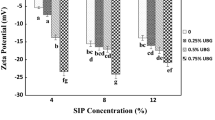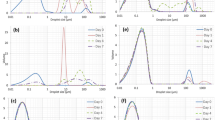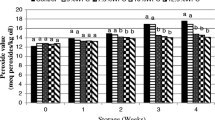Abstract
The shortening of shelf-life of food emulsions is frequently due to poor creaming and lipid oxidation stability. The lipid oxidation of O/W emulsions can be inhibited by rice dreg protein hydrolysate (RDPH); however, emulsions were stabilized by Tween-20. Polysaccharides can control the rheology and network structure of the aqueous continuous phase by increasing viscosity and yield stress, hence retarding phase separation and gravity-induced creaming, especially for xanthan gum. The objective of this research was to evaluate whether emulsions formed with 2 wt% RDPH and stabilized by xanthan gum (0–0.5 wt%) could produce 20 % (v/v) soybean oil-in-water emulsions that had good physical and oxidative stability. The degree of flocculation of droplets as a function of xanthan gum concentration was assessed by the microstructure, rheology, and the creaming index of emulsions. Addition of xanthan gum prior to homogenization had no significant effect on the mean droplet diameter in all emulsions studied. Increase in xanthan gum concentration led to the increase in creaming stability of emulsions, due to an increase in viscosity of the continuous phase and/or the formation of a droplet network with a yield stress, as well as the enhanced steric and electrostatic repulsion between the droplets. Lipid oxidation of the emulsions was significantly inhibited at xanthan gum concentrations of 0.12 wt% or above with RDPH, which could due to the fact that xanthan gum increases the viscosity of the aqueous phase and hindered the diffusion of oxidants to the oil droplet surface area, synergistic effect between RDPH and xanthan gum to suppress oil peroxidation, and metal ion chelation capability of xanthan gum. Thus, stable protein hydrolyzates-type emulsions could be obtained with increasing concentration of xanthan gum.








Similar content being viewed by others
References
Agboola, S. O., Singh, H., Munro, P. A., Dalgleish, D. G., & Singh, A. M. (1998). Destabilization of oil-in-water emulsions formed using highly hydrolyzed whey proteins. Journal of Agricultural and Food Chemistry, 46(1), 84–90.
Bouyer, E., Mekhloufi, G., Rosilio, V., Grossiord, J. L., & Agnely, F. (2012). Proteins, polysaccharides, and their complexes used as stabilizers for emulsions: Alternatives to synthetic surfactants in the pharmaceutical field? International Journal of Pharmaceutics, 436(1-2), 359–378.
Brewer, M. S. (2011). Natural antioxidants: sources, compounds, mechanisms of action, and potential applications. Comprehensive Reviews in Food Science and Food Safety, 10(4), 221–247.
Coupland, J., & McClements, D. (1996). Lipid oxidation in food emulsions. Trends in Food Science & Technology, 7(3), 83–91.
Dickinson, E. (2003). Hydrocolloids at interfaces and the influence on the properties of dispersed systems. Food Hydrocolloids, 17(1), 25–39.
Dickinson, E. (2009). Hydrocolloids as emulsifiers and emulsion stabilizers. Food Hydrocolloids, 23(6), 1473–1482.
Elias, R. J., Kellerby, S. S., & Decker, E. A. (2008). Antioxidant activity of proteins and peptides. Critical Reviews in Food Science and Nutrition, 48(5), 430–441.
Evans, M., Ratcliffe, I., & Williams, P. A. (2013). Emulsion stabilisation using polysaccharide–protein complexes. Current Opinion in Colloid & Interface Science, 18(4), 272–282.
Frankel, E. N. (2005). Lipid oxidation. Dundee: The Oily Press.
Hemar, Y., Tamehana, M., Munro, P. A., & Singh, H. (2001). Influence of xanthan gum on the formation and stability of sodium caseinate oil-in-water emulsions. Food Hydrocolloids, 15(4-6), 513–519.
Kargar, M., Spyropoulos, F., & Norton, I. T. (2011). The effect of interfacial microstructure on the lipid oxidation stability of oil-in-water emulsions. Journal of Colloid and Interface Science, 357(2), 527–533.
Khouryieh, H., Puli, G., Williams, K., & Aramouni, F. (2015). Effects of xanthan–locust bean gum mixtures on the physicochemical properties and oxidative stability of whey protein stabilised oil-in-water emulsions. Food Chemistry, 167, 340–348.
Krstonosic, V., Dokic, L., Nikolic, I., & Milanovic, M. (2015). Influence of xanthan gum on oil-in-water emulsion characteristics stabilized by OSA starch. Food Hydrocolloids, 45, 9–17.
Launay, B., Doublier, J., & Cuvelier, G.(1986). Flow properties of aqueous solutions and dispersions of polysaccharides. In J.R. Mitchell and D.A. Ledward (Eds.), Functional properties of food macromolecules (pp 1–78). London: Elsevier Applied Science.
Leal-Calderon, F., Thivilliers, F., & Schmitt, V. (2007). Structured emulsions. Current Opinion in Colloid & Interface Science, 12(4-5), 206–212.
Liang, Y. C., Gillies, G., Patel, H., Matia-Merino, L., Ye, A. Q., & Golding, M. (2014). Physical stability, microstructure and rheology of sodium-caseinate-stabilized emulsions as influenced by protein concentration and non-adsorbing polysaccharides. Food Hydrocolloids, 36, 245–255.
Lorenzo, G., Zaritzky, N., & Califano, A. (2008). Modeling rheological properties of low-in-fat o/w emulsions stabilized with xanthan/guar mixtures. Food Research International, 41(5), 487–494.
Makri, E. A., & Doxastakis, G. I. (2006). Study of emulsions stabilized with Phaseolus vulgaris or Phaseolus coccineus with the addition of Arabic gum, locust bean gum and xanthan gum. Food Hydrocolloids, 20(8), 1141–1152.
McClements, D. (2005). Food emulsions: principles, practices, and techniques. Boca Raton: CRC.
Morris, E. R., & Foster, T. J. (1994). Role of conformation in synergistic interactions of xanthan. Carbohydrate Polymers, 23(2), 133–135.
Moschakis, T., Murray, B. S., & Dickinson, E. (2005). Microstructural evolution of viscoelastic emulsions stabilised by sodium caseinate and xanthan gum. Journal of Colloid and Interface Science, 284(2), 714–728.
Niu, F. G., Zhou, J. Z., Niu, D. B., Wang, C. Y., Liu, Y. T., Su, Y. J., & Yang, Y. J. (2015). Synergistic effects of ovalbumin/gum arabic complexes on the stability of emulsions exposed to environmental stress. Food Hydrocolloids, 47, 14–20.
Paraskevopoulou, A., Athanasiadis, I., Blekas, G., Koutinas, A. A., Kanellaki, M., & Kiosseoglou, V. (2003). Influence of polysaccharide addition on stability of a cheese whey kefir-milk mixture. Food Hydrocolloids, 17(5), 615–620.
Parker, A., Gunning, P. A., Ng, K., & Robins, M. M. (1995). How does xanthan stabilise salad dressing? Food Hydrocolloids, 9(4), 333–342.
Qiu, C. Y., Zhao, M. M., & McClements, D. J. (2015). Improving the stability of wheat protein-stabilized emulsions: effect of pectin and xanthan gum addition. Food Hydrocolloids, 43, 377–387.
Rodríguez Patino, J. M., & Pilosof, A. M. R. (2011). Protein–polysaccharide interactions at fluid interfaces. Food Hydrocolloids, 25(8), 1925–1937.
Santiago, L. G., Gonzalez, R. J., Fillery-Travis, A., Robins, M., Bonaldo, A. G., & Carrara, C. (2002). The influence of xanthan and gamma-carrageenan on the creaming and flocculation of an oil-in-water emulsion containing soy protein. Brazilian Journal of Chemical Engineering, 19(4), 411–417.
Shimada, K., Fujikawa, K., Yahara, K., & Nakamura, T. (1992). Antioxidative properties of xanthan on the autoxidation of soybean oil in cyclodextrin emulsion. Journal of Agricultural and Food Chemistry, 40(6), 945–948.
Sun, C., Gunasekaran, S., & Richards, M. P. (2007). Effect of xanthan gum on physicochemical properties of whey protein isolate stabilized oil-in-water emulsions. Food Hydrocolloids, 21(4), 555–564.
Velez, G., Fernandez, M. A., Munoz, J., Williams, P. A., & English, R. J. (2003). Role of hydrocolloids in the creaming of oil in water emulsions. Journal of Agricultural and Food Chemistry, 51(1), 265–269.
Wan, Z. L., Wang, J. M., Wang, L. Y., Yuan, Y., & Yang, X. Q. (2014). Complexation of resveratrol with soy protein and its improvement on oxidative stability of corn oil/water emulsions. Food Chemistry, 161, 324–331.
Waraho, T., McClements, D. J., & Decker, E. A. (2011). Mechanisms of lipid oxidation in food dispersions. Trends in Food Science & Technology, 22(1), 3–13.
Ye, A., Hemar, Y., & Singh, H. (2004). Enhancement of coalescence by xanthan addition to oil-in-water emulsions formed with extensively hydrolysed whey proteins. Food Hydrocolloids, 18(5), 737–746.
Zhao, Q., Selomulya, C., Wang, S. Q., Xiong, H., Chen, X. D., Li, W., Peng, H. L., Xie, J. H., Sun, W. J., & Zhou, Q. (2012). Enhancing the oxidative stability of food emulsions with rice dreg protein hydrolysate. Food Research International, 48(2), 876–884.
Zhu, X. Q., Ye, A. Q., Teo, H. J., Lim, S. J., & Singh, H. (2014). Oxidative stability of fish oil-in-water emulsions under high-pressure treatment. International Journal of Food Science and Technology, 49(6), 1441–1448.
Acknowledgments
The authors gratefully acknowledge the financial support provided by the National High Technology Research and Development Program of China (863 program) (2013AA102203-5), Natural Science Foundation (20142BAB213006, 20151BBF60041), and Department of Education Fund (GJJ13020) of Jiangxi Province.
Author information
Authors and Affiliations
Corresponding authors
Rights and permissions
About this article
Cite this article
Chen, X., Li, W., Zhao, Q. et al. Physical and Oxidative Stabilities of O/W Emulsions Formed with Rice Dreg Protein Hydrolysate: Effect of Xanthan Gum Rheology. Food Bioprocess Technol 9, 1380–1390 (2016). https://doi.org/10.1007/s11947-016-1727-9
Received:
Accepted:
Published:
Issue Date:
DOI: https://doi.org/10.1007/s11947-016-1727-9




